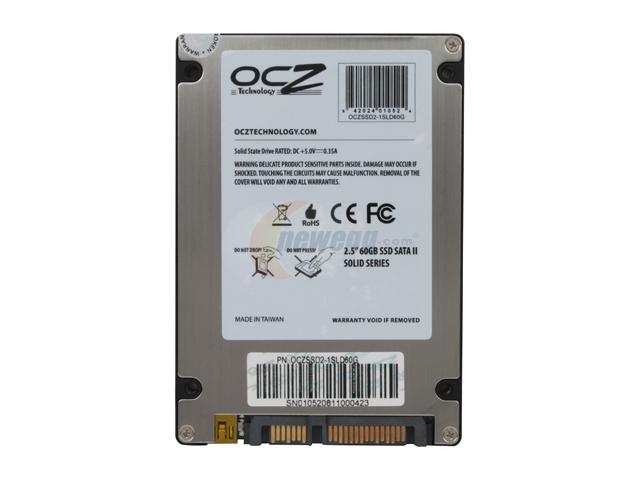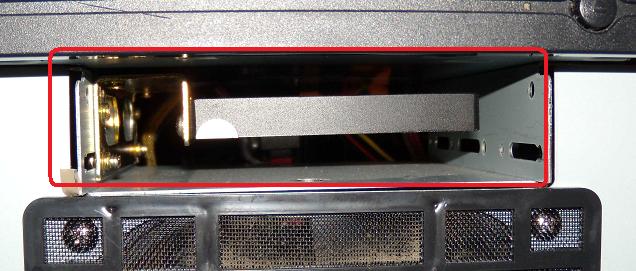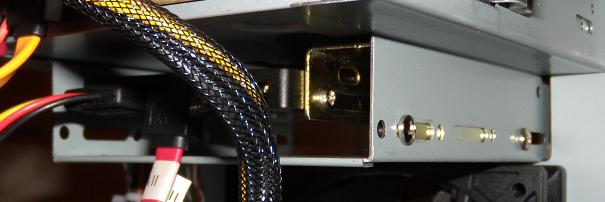I picked up a OCZ 60GB SSD drive from NewEgg a couple of days ago. OCZ Solid Series OCZSSD2-1SLD60G 2.5" 60GB SATA II (About $103US after rebates) I used it to replace my boot drive in my Intel computer. (The one in my computer details.)
It's a 2.5" SSD, same as a laptop drive. Of course I didn't notice that it came without a 3.5" adapter.I retrofitted a 3.5">5.25" adapter by just using one side and filing out the screw slots to match the SSD. I mounted it in the unused floppy bay. It also has a mini-USB connector, so it could be used in place of a USB drive flash drive.
Some shots of it installed.
Benchmark with the 320GB WD SATA drive that I replaced and one with the SSD:
There's quite a bit of improvement in the read speed. The write speed isn't that great, but I just cleaned up my boot drive and cloned it to the SSD and nothing else. It worked the same as any other SATA drive and my OS recognized it with no problems. OCZ has a lot of info on optimizing the drive and the performance should improve after that. But not bad for just out of the box.
And faster read speed is what I wanted anyway. The OS boots about 30% faster and programs like Photoshop load about 50% faster.
Try StreamFab Downloader and download from Netflix, Amazon, Youtube! Or Try DVDFab and copy Blu-rays! or rip iTunes movies!
+ Reply to Thread
Results 1 to 16 of 16
Thread
-
-
Any difference in accessing files of large sizes and programs,more details or my cat gets it.Graphs dont tell me much in real world use.
I think,therefore i am a hamster. -
I've only had it installed about an hour.
 It's a bit too small for me to try a BD>MKV conversion.
It's a bit too small for me to try a BD>MKV conversion.  Judging from the mediocre write speed, I think reading is probably it's best use. Actually, I was surprised my SATA boot drive did that well. The identical drive in the same computer is a fair bit slower. But it also has a lot of files on it. I deleted all my restore files from the boot drive, along with all temp files to keep the boot size down before I cloned it. It's using about half it's capacity, around 28GB. I would definitely recommend a 120GB drive unless you keep close track of your boot storage size.
Judging from the mediocre write speed, I think reading is probably it's best use. Actually, I was surprised my SATA boot drive did that well. The identical drive in the same computer is a fair bit slower. But it also has a lot of files on it. I deleted all my restore files from the boot drive, along with all temp files to keep the boot size down before I cloned it. It's using about half it's capacity, around 28GB. I would definitely recommend a 120GB drive unless you keep close track of your boot storage size. 
I found a optimizing program for it, so I may try that next. I have a backup of my boot drive on one of my spare drives, so if I mess it up too much, I should still be able to boot the computer. -
When I first saw these in a SanDisk booth in 2007, they said the main advantage was for laptop power management. Fast memory would be costly.
Recommends: Kiva.org - Loans that change lives.
http://www.kiva.org/about -
I ran the optimizer program and it slowed the drive down a bit.

The OCZ forum mentioned a few things:
A SSD works best with Vista SP1 or W7. XP may give you some problems. (Seems to be mostly a driver and MB problem. Vista drivers seem to be a bit newer.)
AHCI must be disabled in the bios, this is especially true in Vista. It slows down the drive most times.
Chipset drivers for your motherboard become very important, always use the latest drivers or you may see performance issues. ( I saw no difference when disabling AHCI. I turned it back on. I guess it depends on the SATA controller and the drivers.)
DO NOT DEFRAGMENT your SSD, it is not necessary. Wear leveling technology purposely "fragments" the data to ensure the consistent life of the drive.
VISTA has an Auto defrag feature that is enabled by default (defragging is on a schedule) this should be disabled after your drive is installed. (This is easy to do in Vista. Just select the drive and turn off auto defragging.)
I still need to run some real tests when I have the time.
Other things: The drive runs very cool. Mounting isn't critical. Vibration doesn't matter. You can even Velcro it somewhere inside the case. I may need to properly set up the drive first and reinstall the OS. I have a clone copy of the boot drive ready. With the proper mounts, you can use four or maybe six of them in a 5.25" bay. Nice for RAID if you can afford it.
The motherboard and drivers and OS used do make a difference. Maybe the best use would be in a laptop to replace a slower 4200RPM drive. If the laptop support it.
A couple of OCZ links: http://www.ocztechnologyforum.com/forum/showthread.php?t=40561
http://www.ocztechnologyforum.com/staff/ryderocz/ssd/ssd_config.pdf -
Also, don't forget to redirect your TEMP files to Ramdisk to minimize writing to the SSD. Those cells have a limited write cycle in them.
-
Thanks, I've done that. Still working on some tweaks for the drive. AHCI seems to work fine with this drive, so I left it in place. But I need to check to see if I have the latest drivers. So far I've left my CPU and RAM overclock settings in place also.
Looking at the OCZ site, my write speeds are about normal and my read speeds are very good.
I'm using the ATTO Disk Benchmark program for benching the drives, recommended by OCZ. http://www.techpowerup.com/downloads/1137/ATTO_Disk_Benchmark_v2.34.html
The SSD still shows about 170MB/s read and about 90MB/s write. This is with data chunks of 64MB>8192MBs.
It shows one of my mostly empty 500G HDDs running at about 95MB/s transfer rate, so that's a good start number.
One of the other external SATAs that is mostly full is at about 50MB/s.
On both of them R/W speeds are about equal. This at least gives me some comparisons.
Still a lot of reading to do.
-
Typical 7200rpm SATA/ATA sustained rates are 70 to 90 MB/s at the fast end to 55 to 65 MB/s at the slow end for both read and write. High RPM Raptors are more in the 90-140 MB/s range.Originally Posted by redwudz
Full drives with fragmentation may slow more due to seeks.Recommends: Kiva.org - Loans that change lives.
http://www.kiva.org/about -
ok so the solid state stuff is not supposed to have moving platters like traditional harddrives right?
Donatello - The Shredder? Michelangelo - Maybe all that hardware is for making coleslaw? -
Similar to a giant flash SD card but with SATA interface.Originally Posted by yoda313
Actually it is a giant flash SD card but with SATA interface.
Speed of flash RAM varies but is still much slower than DDR2 or DDR3.
The advantage of flash RAM is it holds its state when you turn power off. It doesn't require a full reboot.
The disadvantage is cost and write wear.Recommends: Kiva.org - Loans that change lives.
http://www.kiva.org/about -
@eddv - thanks.
Donatello - The Shredder? Michelangelo - Maybe all that hardware is for making coleslaw? -
There are different types of SSD, explained hereOriginally Posted by yoda313
http://en.wikipedia.org/wiki/Solid-state_driveRecommends: Kiva.org - Loans that change lives.
http://www.kiva.org/about -
Well, with those improved read speads, speeding up programms is its primary use I would say. However, theres this little line in the Adobe CS4 system requirements:Originally Posted by redwudz
So eh, pretty fucked up hmm?24.3GB of available hard-disk space for installation; additional free space required during installation (cannot install on flash-based storage devices)
I'm not sure I understand why there would be a difference between install to HD and flash-based drive? -
They may be talking about the PS scratch/temp files. But I put them on one of the HDDs. I'm running CS2 and haven't noticed any problems. But CS4 may be quite a bit different. I would run out of room fairly quickly if I used the SSD for any sort of temp files.
 And ATI and other software seem to always want to put their installer files on the boot drive, so I have to change that all the time.
And ATI and other software seem to always want to put their installer files on the boot drive, so I have to change that all the time. 
I installed the latest Intel HDD drivers for my motherboard, about the same performance as before. The write peaks out at about 100MB/s and the read is at about 170MB/s. That's with AHCI on, which I might try turning off again, though it seems to help the performance of the HHDs.
EDIT: Looking back at my earlier benchmark, I did gain some write speed with the newer drivers.

I moved a 8GB file off the SSD a couple of minutes ago to one of my HDDs and Windows reports about a 100MB/s transfer rate. -
I remember when we ran RAID 0 for Photoshop scratch disks back in the day (early-mid 90's). When using large 35mm scan files and many layers/undos, page swaps to the scratch drive were the main productivity delay. Today, one can afford enough DRAM for most needs plus standard hard drives far exceed the speed of mid 90's SCSI RAID.
So is faster Photoshop launch really an issue? SSD won't help much for the scratch drive due to slower writes. Might as well just use a 7200rpm or Raptor for scratch (except for noise factor).
For Photoshop this only becomes an issue when using large RAW files or high resolution scans. It shouldn't be a problem for typical jpg files. For that DRAM is enough.Recommends: Kiva.org - Loans that change lives.
http://www.kiva.org/about -
Photoshop is one of my slowest loading programs, so it was noticeable when it loaded faster. I haven't really noticed any speed increase in the program itself, though I haven't used it much since the SSD was installed. I do have 4GB of DDR2 1233 RAM, so that is probably a bigger help.
The main issue I have noticed is that the 60GB SSD is too small for most systems. Vista uses a lot of space, along with my installed programs. I'm trying to keep the free space at about 50% or ~25GB to help keep the speed up. I've moved most all temp files to different drives. A 120GB SSD would probably be a better choice, but was more than I wanted to spend for a experiment. If the drive doesn't work out, I can use it in my laptop, or just as a external flash drive. It does have a mini USB connector, so it is fairly versatile.
Lack of noise from it doesn't much matter, as my case, GPU and CPU fans, along with the optical drives are the biggest noise producers in the PC. It also runs very cool, so heat isn't a issue.
Some SSD users are putting four to six SSDs in a 5.25" bay and RAIDing them. That does seem like overkill. The RAID controller would be very critical for this usage. And controllers are just catching up to SSDs.
The RAID controller would be very critical for this usage. And controllers are just catching up to SSDs.
I tried turning AHCI off in BIOS and that slowed the drive read times by about 10MB/s. No effect on write times. The OCZ forum said the opposite, that having AHCI on would slow the controller. I'll turn it back on.
Vista SP1 and W7 are somewhat optimized for SSD drives. Other OS's like XP may have problems, but most likely with the available controller software. A interesting setup would be a PC running the final version of W7, a fast i7 CPU and MB, along with 4GB+ DDR3 RAM and a 120GB or larger SSD. (But a bit beyond my price range at present. )
)
So far, I haven't had any of the problems sometimes associated with SSDs. It installed and worked just like any other HDD. I've still got a bit more to learn about it, but I'm happy for the moment.
Similar Threads
-
SSD's...a few questions
By Moontrash in forum ComputerReplies: 1Last Post: 17th Dec 2011, 21:12 -
Anybody Use An SSD?
By Ron B in forum ComputerReplies: 16Last Post: 29th Jan 2011, 16:21 -
SSD Awesomeness!
By Browncoat in forum Latest Video NewsReplies: 4Last Post: 7th May 2009, 01:12 -
Do SSD's need defragging?
By alegator in forum ComputerReplies: 2Last Post: 2nd Dec 2008, 14:07 -
anyone here using as SSD drive yet?
By lordhutt in forum ComputerReplies: 23Last Post: 13th Oct 2008, 09:16










 Quote
Quote